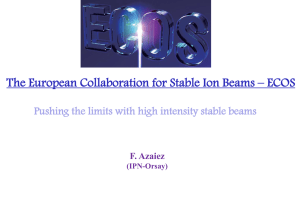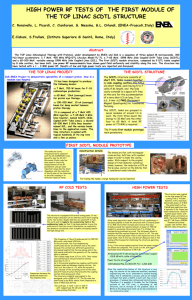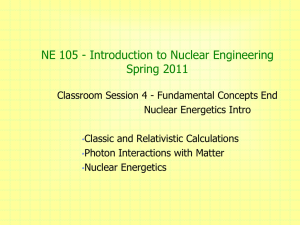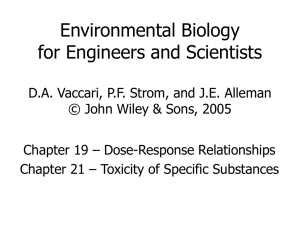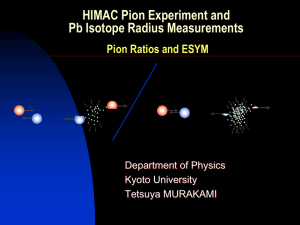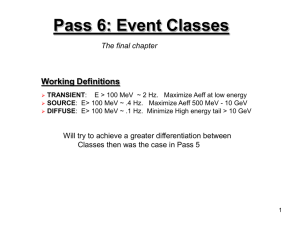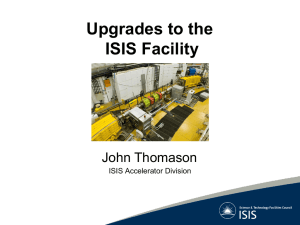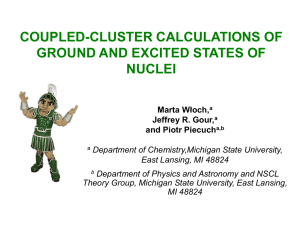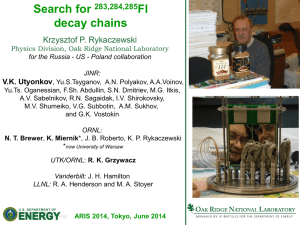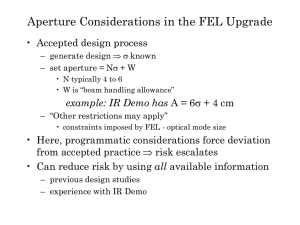ecos-lince
advertisement
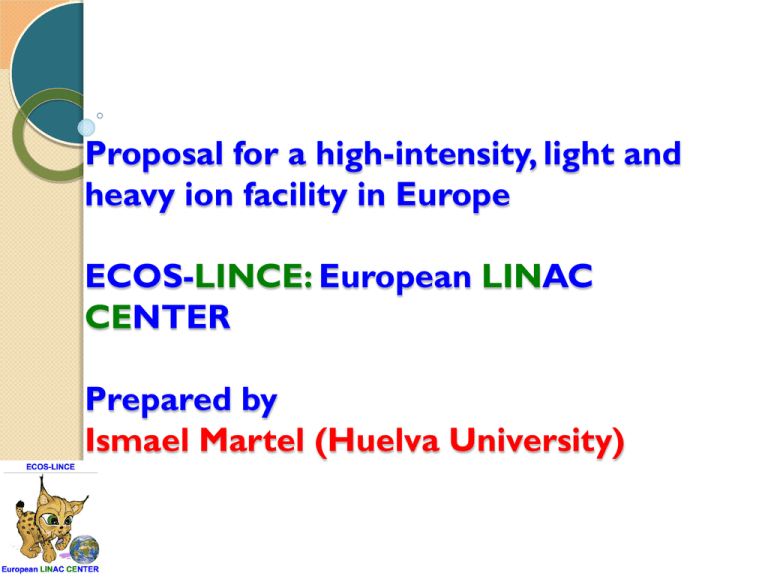
Proposal for a high-intensity, light and heavy ion facility in Europe ECOS-LINCE: European LINAC CENTER Prepared by Ismael Martel (Huelva University) HIGH INTENSITY STABLE ION BEAMS IN EUROPE This document was prepared by the ECOS (European COllaboration on Stable ion beams) working group, in order to describe the research perspectives with high intensity stable ion beams, to help categorize existing facilities and to identify the opportunities for a dedicated new facility in EUROPE ECOS Working group: Faiçal Azaiez (Chair) (IPNO Orsay) Giacomo de Angelis (LNL Legnaro) Rolf-Dietmar Herzberg (Liverpool) Sigurd Hofmann (GSI Darmstadt) Rauno Julin (Jyväskylä) Marek Lewitowicz (GANIL Caen) Marie-Helene Moscatello (GANIL Caen) Anna Maria Porcellano (LNL Legnaro) Ulrich Ratzinger (Frankfurt) ECOS working group conclusions IV: Concluding remarks and recommendations …“The long-term goal for a new dedicated high intensity stable ion beam facility in Europe, with energies at and above the Coulomb barrier, is considered to be one of the important issues to be discussed in the next Long Range Plan of the nuclear physics community.”… LINCE proposal ECOS facility: a FIRST CLASS High intensity heavy-ion accelerator for stable ions, with energies at and above the Coulomb barrier. LINCE; high-intensity superconducting LINAC - Wide range of ions, from protons to Uranium - Wide range of energies, up to 10 A MeV for 238U - High Intensity accelerator (1 mA light ions 10 pA heavy ions) LINCE: energy booster using heavy-ion synchrotron: - 50 MeV/u for light ion species - 200 MeV for deuterons. PROGRAM: - Basic and Fundamental problems in nuclear physics - Applications of nuclear physics - Interaction with Industry Basic Nuclear Physics The totality of the ECOS physics case - Nuclear structure, low, medium and high spin - Reaction mechanisms - Charge-exchange reactions - Isomers - Ground-state properties - Astrophysics - Superheavies - Nuclear equation of state (EOS) - Fundamental physics: neutrinoless double-beta decay …Studies where one can benefit from high intensity stable beams Typical experimental setup Separator Spectrometer Gamma-particle DEVELOPMENTS - High resolution spectrometers and recoil separators with high rejection power (MAGNEX, VAMOS, PRISMA,…) - High power targets - New generation of gamma & particle detectors (FAZIA, AGATA,…) with new generation electronics and data correlation systems. + Long and dedicated beam time!! Fusion energy research Material research for energy production Fusion energy research: aiming at qualifying advanced materials resistant to extreme conditions, specific to fusion reactors like ITER. Intense ion beams of moderate energy are needed to simulate fusion reactor conditions. (CIEMAT) IFMIF project: a 40 MeV, 125 mA deuteron + lithium target neutrons to test materials for first generation of fusion reactors the DEMO reactor Cocktail beams à la JANNUS Double, triple charged ions Condition: Same A/q EX: 56Fe (14+) + 4He(1+) Radioisotope production Modern radioisotopes are currently investigated/used to treat in a more efficient way the different tumours and cancer disease of our society. What LINACs can do better (than cyclotrons) ECOS-LINCE 2013, Ulli Coester, Grenoble Aerospace electronics High intensity ion beams are used in aerospace programs for radiation resistant electronics and in nuclear energy applications. Quality tests are required in order to accomplish with UE safety regulations for energy control and aerospace on-board electronics. Research can be centred on the impact of radiation on the response of new device technologies and single-event effects in new technologies and ultra-small devices. Highly demanded ions & energies ~10 MeV/u Typical figures from RADEF, Finland LINCE-main parameters For the program on basic nuclear physics and applications it is proposed the following parameters: Protons to Uranium: 1 mA max intensity eg., LINAC: E from 40 keV/u to (8.5 – 45) MeV/u depending on A/q SYNCHROTON: 50 MeV/u for light ion species & 200 MeV for deuterons. Full-SC ECR ion source 14.5-18 GHz RFQ for 1 ≤ A/q ≤ 7 Superconducting cavities Energies reachable with 4 Cryo-modules: COMPACT linac. 48Ca (8+) > 10 pA 7000 hours of availability, with 5000 hours for ECOS science and 2000 hours for Applications Pre-design studies Partially funded by R&D projects at University of Huelva, Spain Choice of 1st harmonic (fundamental) defined minimum time of flight: 50 ns Fundamental frequency: 18.1875 MHz (54.98 ns) from RF amplifier market HIbuncher For protons and alphas: F = 36.375 MHz need double buncher (space charge issues) Frequency of RFQ, F = 72.75 MHz (4th harm.) ◦ E in/out = 0.04A MeV / 0.5A MeV Frequency of SC cavities : 72.75 MHz (4th harm.) and 109.125 MHz (6th harm.) Multi-Harmonic Buncher is MANDATORY A/Q E/A Example Charge state 1 42 H 1+ 2 25 D 1+ 3 18 18O 6+ 4 14 32S 8+ 5 12 48Ca 10+ 6 10 48Ca 8+ 7 8 238U 34+ Intensity: < 1mA Pre-design activities LINCE LINAC layout Pre-design activities Building integration Proposed layout of LINCE MHB1 f = 18.125 MHz MHB2 f = 36.250 MHz RFQ f = 72.75MHz C1: β = 0.045, f = 72.75 MHz C2: β = 0.077, f = 72.75 MHz C2: β = 0.077, f = 72.75 MHz C3: β = 0.15, f = 109.12 MHz Rebuncher LINCE LINAC: “60 MV equivalent electrostatic accelerator” The experimental equipment Experimental equipment has to be defined and built - High Resolution Fragment separator: high selectivity at high intensity - High Resolution Spectrometer - Benefit of already detectors being build at EU 1. FAZIA 2. AGATA 3. GASPARD/HYDE Pre-design studies of LINCE On-going actions at University of Huelva Beam dynamics, transport to exp. lines and building integration Design studies of ECR, buncher, warm magnets, RFQ, SC QWR, couplers, SC magnets, and criomodules RFQ model in Al (one full section) and in Cu (one vane) + brazing tests Ion source test bench Model of MH Buncher Machining and welding tests with Nb Parts of one QWR resonator Cryolab for cavity testing, including one multi-propose cryostat RF lab for testing resonators Specific design of selected elements Industry & Universities Technology Transfer Project funded by National Government in Spain (5 Universities, 7 large companies, 5 small companies). Preliminary matrix cost Estimated cost of LINAC Complete LINAC accelerator with servitudes, without building and experimental facilities : 48 M€ Estimated operation cost : 5 M€/y EU Convergence funds with help of participating Institutes General operation Host region can cover part of the personnel and the operation costs Participating institutes can collaborate with personnel, instruments, funds… A legal framework should be defined for the full facility (International ECOS collaboration) Proposed planning Predesign Detailed design Construction 2014 2015 2017 2016 2018 Commis sioning 2019 Construction decision 2020 2021 ECOS-LINCE: Possible European Sites SPAIN PARQUE CIENTÍFICO TECNOLÓGICO DE HUELVA (PCTH, Aljaraque) Huelva University 3 Km Punta Umbría Beach Resort, 3 Km ECOS-LINCE European LINAC CENTER Superheavies Astropysics picobarn!! at relevant energies < 1 MeV, few GK Extrapolation from higher energies by using the astrophysical S(E) factor: S(E) = (E) E exp(2πη) DIRECT & INDIRECT METHODS DIRECT METHODS -Increase number of detected particles ( “brute force”: intensity, detector eff.) - Reduce the background - Fight with electron screening: theory does not work!! INDIRECT METHODS Coulomb dissociation: Determine the absolute S(E) factor of a radiative capture reaction A+x B+ studying the reversing photodisintegration process B+ A+x ~100 MeV/A Asymptotic Normalization Coefficients (ANC): Determine the S(0) factor of the radiative capture reaction, A+x B+ studying a peripheral transfer reaction into a bound state of the B nucleus. Trojan Horse Method (THM): Determine the S(E) factor of a charged particle reaction A+xc+C selecting the Quasi Free contribution of an appropriate A+a(x+s) c+C+s reaction. Transfer and fusion reaction studies - Pair correlations (nn,pp,np channels) in transfer reactions at sub-barrier energies - Charge exchange reactions - Multinucleon transfer reactions (neutron rich nuclei) and effects on induced fission and quasi fission processes - Hindrance phenomenon in sub-barrier fusion reactions Nuclear structure at low, medium and high spin In-flight production of exotic nuclei at reaction targets Typical beams 40Ar ~ 14 MeV/u 86Kr ~ 8.5 MeV/u 84Kr ~ 10 MeV/u 136Xe ~ 7 MeV/u Exotic isotope production: Height of the Coulomb barrier ~ 4 to 5 MeV/nucleon: compound nucleus/fus.evap reactions, E ~ Eb proton rich reactions of nucleon exchange, E>> Eb neutron rich Compound nucleus/fus. evap reactions Basic mechanism for production of proton rich nuclei Neutron rich: preferably ”cold“ processes with minimum neutron loss. Reactions of heavy ions with energies around > 10 MeV/u M. Veselsky, G.A. Souliotis, Nuclear Physics A 765 (2006) 252; A 781 (2007) 521. G.A.Souliotis et al., PRC 84, 064607 (2011); M. Veselsky,et al., Nucl. Phys. A 872 (2011) 1. Physics beyond the Standard Model Nuclear matrix elements Xsections: ~nanobarn!! High intensity ion beams Pre-design studies TRACK 3D (P. Ostroumov, A.Villari, I. Martel) Reliable beam dynamics with low beam losses Calculated full transmission for H-I > 75% LINCE “energy booster” HEAVY-ION SYNCHROTON: - LINAC injection at 15 MeV/u - OUTPUT: 50 MeV/u for light ion species & 200 MeV for deuterons - Design study to be done
